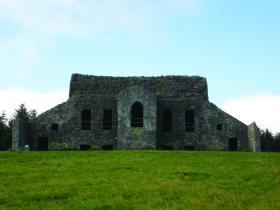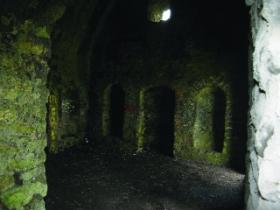The Hellfire Club, Co. Dublin
Published in 18th-19th Century Social Perspectives, 18th–19th - Century History, Features, Issue 3 (May/June 2010), Volume 18
The north elevation.
It is thought that the remarkable lodge on Mount Pelier Hill was erected c. 1725. The game-rich lands in the foothills of the Dublin Mountains had come into the possession of William Conolly of Castletown House when he purchased Rathfarnham Castle in 1724, and this hilltop with its spectacular views must have seemed an ideal location for a hunting lodge. Because of its vaulted stone roof, the building is one of the best-preserved early eighteenth-century hunting lodges in Ireland, in spite of having been burnt down, robbed of all its decorative stone to build a later lodge downhill to the north, and suffering a bonfire of tar barrels on its roof to celebrate the arrival of Queen Victoria in 1849.
In its original condition it must have been most impressive. In the centre of a well-proportioned Palladian façade a flight of cut-stone steps led up to the fan-lit entrance door on the first floor, which opened into a porch flanked by wall niches. Off the inner stair hall were the two main reception rooms, each with fireplaces and two tall windows looking out over that expansive view of the city and the bay. The number and distribution of wall niches in the reception rooms suggest that the original interior finishes were more than utilitarian. Over one of these rooms there was a third storey, probably a bedroom, while on the ground floor were the kitchen and servants’ quarters. Another room, possibly a bedroom, occupied a return at the rear: at ground-floor level beneath this is a room that may have been a wine cellar. At either end of the house, under lean-to roofs, there were stables, possibly one for horses and one for hounds, and outside one of them a stone mounting-block survives.

The number and distribution of wall niches in the reception rooms suggest that the original interior finishes were more than utilitarian. (NIAH)
The building was sold after Conolly’s death in 1729 and became a meeting place for the young bucks who made up the Irish version of London’s Hellfire Club—hence the name. There are many lurid and probably exaggerated stories of their excesses. Thomas Conolly, grandson of William, is said to have met the devil there during a card game, which ended with the devil flying up in a burst of flame and out through the high window in the gable. The only incident on record, however, is the death of Charles Cobbe, son of the archbishop of Dublin, in a duel in July 1751.
At some time during the 1750s the interior was seriously damaged in a fire, and the place was abandoned. When Lord Ely of Rathfarnham built a hunting lodge a mile or so downhill in 1763, the old lodge was stripped of all its finer finishes, including the stone steps to the door, the window-sills and the surrounding walls, which were brought downhill to be used in the new building.
Even in its present condition, however, it seems clear that this building is the work of an accomplished architect. The most likely candidate would have to be Edward Lovett Pearce (1699–1733). In 1724, the year that Conolly came into possession of the Rathfarnham lands, Pearce returned from his architectural studies in Italy and was employed at Castletown. It does not seem unreasonable to suppose that Conolly, during the course of his discussions with Pearce, might have taken him to see the site on Mount Pelier Hill where he proposed to erect a hunting lodge, and subsequently obtained a sketch design for it. HI
Michael Fewer is an architect and writer. Series based on the National Inventory of Architectural Heritage’s ‘building of the month’, www.buildingsofireland.ie.
















